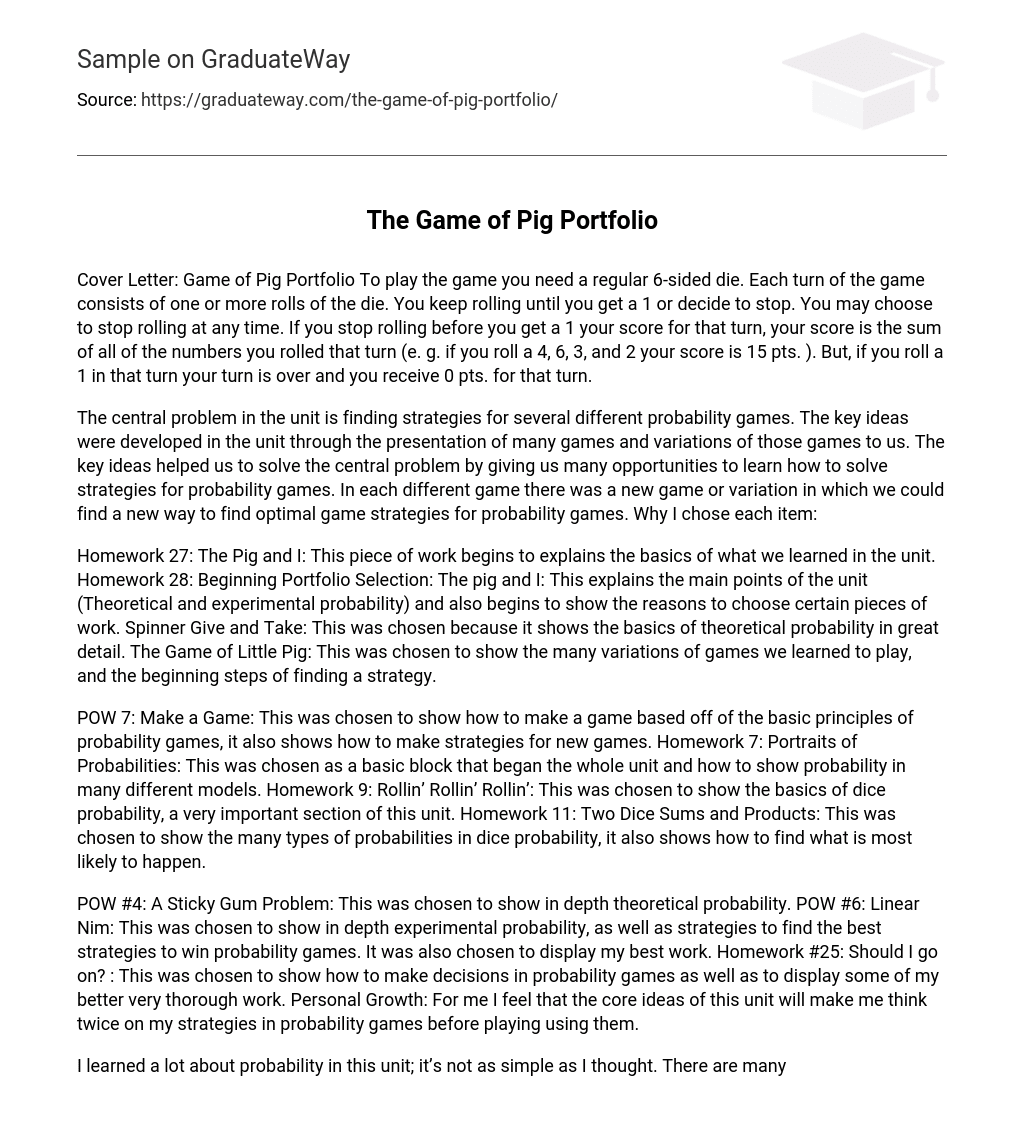Cover Letter: Game of Pig Portfolio To play the game you need a regular 6-sided die. Each turn of the game consists of one or more rolls of the die. You keep rolling until you get a 1 or decide to stop. You may choose to stop rolling at any time. If you stop rolling before you get a 1 your score for that turn, your score is the sum of all of the numbers you rolled that turn (e. g. if you roll a 4, 6, 3, and 2 your score is 15 pts. ). But, if you roll a 1 in that turn your turn is over and you receive 0 pts. for that turn.
The central problem in the unit is finding strategies for several different probability games. The key ideas were developed in the unit through the presentation of many games and variations of those games to us. The key ideas helped us to solve the central problem by giving us many opportunities to learn how to solve strategies for probability games. In each different game there was a new game or variation in which we could find a new way to find optimal game strategies for probability games. Why I chose each item:
Homework 27: The Pig and I: This piece of work begins to explains the basics of what we learned in the unit. Homework 28: Beginning Portfolio Selection: The pig and I: This explains the main points of the unit (Theoretical and experimental probability) and also begins to show the reasons to choose certain pieces of work. Spinner Give and Take: This was chosen because it shows the basics of theoretical probability in great detail. The Game of Little Pig: This was chosen to show the many variations of games we learned to play, and the beginning steps of finding a strategy.
POW 7: Make a Game: This was chosen to show how to make a game based off of the basic principles of probability games, it also shows how to make strategies for new games. Homework 7: Portraits of Probabilities: This was chosen as a basic block that began the whole unit and how to show probability in many different models. Homework 9: Rollin’ Rollin’ Rollin’: This was chosen to show the basics of dice probability, a very important section of this unit. Homework 11: Two Dice Sums and Products: This was chosen to show the many types of probabilities in dice probability, it also shows how to find what is most likely to happen.
POW #4: A Sticky Gum Problem: This was chosen to show in depth theoretical probability. POW #6: Linear Nim: This was chosen to show in depth experimental probability, as well as strategies to find the best strategies to win probability games. It was also chosen to display my best work. Homework #25: Should I go on? : This was chosen to show how to make decisions in probability games as well as to display some of my better very thorough work. Personal Growth: For me I feel that the core ideas of this unit will make me think twice on my strategies in probability games before playing using them.
I learned a lot about probability in this unit; it’s not as simple as I thought. There are many calculations you must learn how to do and there is obviously so much more behind the strategies and probabilities that I am yet to discover, for example, statistics class. Best Strategy: The best strategy is to get to 20 points and end your turn. This should take roughly 5 rolls of the dice seeing as the expected value per roll is 4. Four multiplied by five is 20. You should take 5 rolls because after five rolls the expected value of points begins to go up by smaller and smaller margins.





